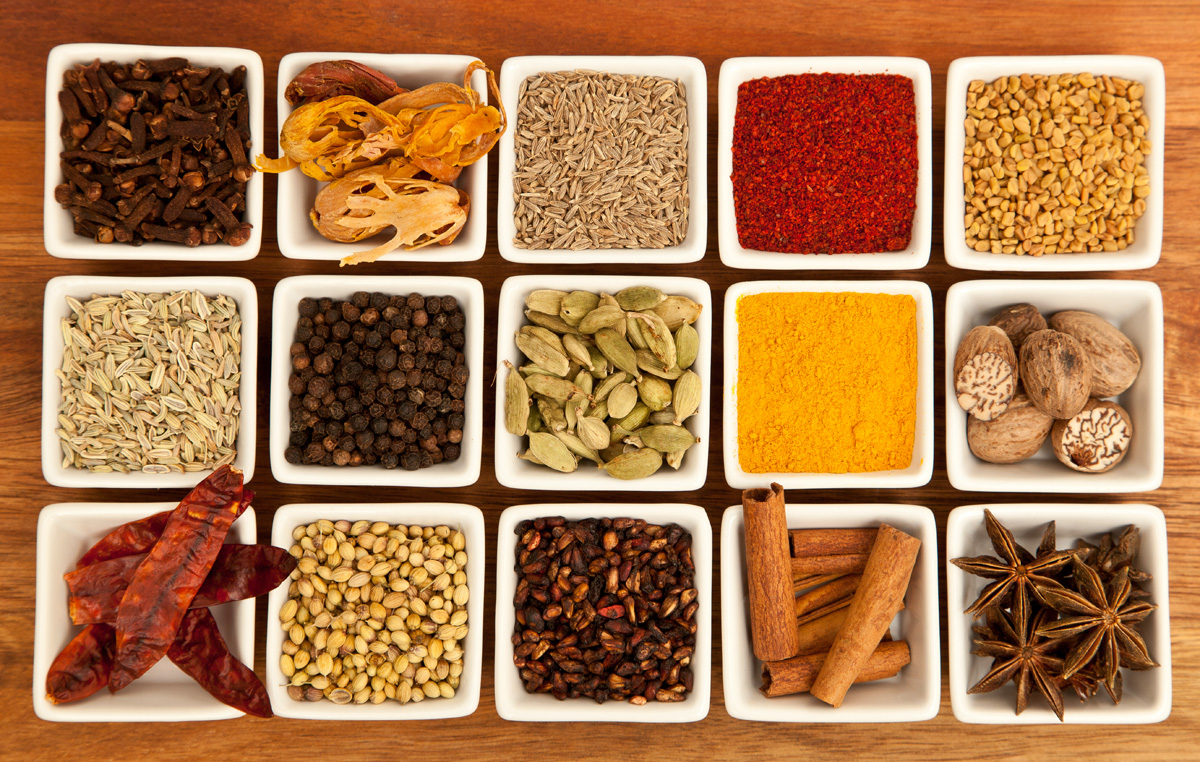
Why Soopa Sastra? Elsewhere cooking is referred to specifically as Paaka, in Sanskrit. The rationales for this are manifold. The first Sanskrit text known to us on the culinary arts is in fact called Soopa Sastra, and is credited to Sage Sukesa. In addition, “The cook went by many names, such as alarika, soopakaara, odanika, bhojanadatr, and sudas”. [1, 108] Further, much like Dhanurveda refers to the Military Arts (despite Dhanur being ‘bow’), Soopa Sastra refers to the Culinary Arts despite soopa meaning only Soup (or broth). Finally, Paaka refers to cooking, but Soopa is a broader term encompassing Cuisine in general. Thus, Soopa Sastra is Culinary Science which encompasses not only Cooking, but Civilized Dining as well.
For all these reasons, Soopa Sastra is the more preferable phrase for the present time.
Introduction
What did our ancestors eat? Was it similar to what we eat now? Is it all a patchwork of regional cuisines or are there Pan-Indian commonalities?
More importantly, as one culinary author asks, “What do you mean by ‘good food’? Good to the taste? By ‘good’ do you mean food which has inherent values, i.e. values which are good for the well-being of the eater?”. [7, 16] Or does this merely mean food which satisfies? As in all things, the key to life is balance. It is only when there is imbalance that man either becomes deprived or depraved. Between being dull and being diseased is the middle path.
“Food was also part of the ‘discipline’ in daily living of the Hindu way of life….The peak of ascetic glory was to be able to live on air and water and the perfect ‘yogi’ was revered because he had taught himself to subsist on a mi[n]imum of food. The bogi learnt the pleasures of eating, and descended to eating two meals a day, while the rogi was the gourmet given to self-indulgence and excess which resulted in ill-health. Hence the same word rogi is used for a man sick with disease (from roga=disease).” [7,17]
Thus, one need not be a yogi to live a healthy life. The wise man or wise woman finds balance and eats in moderation—knowing to generally eat healthy, while responsibly indulging on special occasions. Thus, between the yogi and the rogi is the bhogi. Herein lies the importance of the Rajbhog.
Whether it was the Rajabhoga (King’s meal) or the saamaanya bhojana, food was so important that cities themselves have been named after food items. One such prominent example is Vidarbha‘s Amraoti (not to be confused with Andhra’s Amaravati). The original name of this Maharashtrian municipality was in fact Audambaravati, named after the Indian fig (udambara). [1. 35]
Vegetarianism is also a frequent flower in the garland of Dharma. Not only those following the Sattvic way of life, but also The Buddha favoured ahimsa to animals, though he permitted non-veg in cases of unintentional slaughter. [1,55] Jainism of course stands as the most dedicated to the concept of non-injury to animals, and many Sikhs observe vegetarianism (except in times of war).
Buddhism, Jainism and Sikhism crystallized out of a Hindu matrix. In terms of food practices they have naturally many features in common with the Hindu ethos. [1.70]
Despite the large contingents of vegetarians (sakaharis) and non-vegetarians (maamsahaaris), one dietary thread is common to them: the sanctity of the cow.
 Contrary to murkhapanditas peddling ‘beef in vedas’ theories, the cow was—and is—aghnya, that which should not be killed.
Contrary to murkhapanditas peddling ‘beef in vedas’ theories, the cow was—and is—aghnya, that which should not be killed.
the Rigveda has a whole hymn to nutrition (peelu) in which only vegetable foods are listed, and carries two verses in praise of ‘the cow, Aditi, the sinless’. The word gau is used for the cow, and the term aghnyaa (‘not to be eaten, inviolable’) is employed no less than sixteen times, in contrast to three references to the bull, using the masculine form aghnya [1, 55]
These go-bhakshaks advocating a go-mamsa theory of Dharma are high on Ego and low on Sattva guna. This age old food restriction characterises our Dharmic way of life, yet nevertheless leaves a wide variety of not only other meats, but also a myriad of fruits, vegetables, grains, beverages, divine dishes, and savoury sweets. Whether veg or non-veg, let us all survey together what is common in their presentation and preparation.
History of Culinary Unity
“May for me prosper, through the sacrifice, milk, sap, ghee, honey, eating and drinking at the com-mon table, ploughing, rains, conquest, victory, wealth, riches. May for me prosper, through the sacrifice, low-grade food, freedom from hunger, rice, barley sesame, kidney beans, vetches, wheat, lentils, millets, panicum grains and wild rice. May for me prosper, through the sacrifice, trees, plants, that which grows in ploughed land, and that which grows in unploughed land.” —Yajurveda [1, 28]
The influence of the Vedas on disparate spheres of life is so widespread that even food and agriculture are not untouched by it. We see from this quote from the Yajur Veda that agriculture was very much a part of Vedic Society. Rather than a Central Asian pastoral culture, we see the mark of an agricultural one. This centrality of settled life would be seen in later periods as well, and we see the sophistication of irrigation driven farming.
In the Ramayana, the land of Kosala is eulogized by Rama as adhsvamatrakah, that is, as relying on irrigation rather than rainfall for its fecundi-ty. The Arthashastra of Kautilya (c.300 BCE) has many references to an extensive system of irrigation. [1, 29]
What’s more, one notes the antiquity of rice consumption in Indic Society. Various texts attest not only to its import, but also to the technical details of cultivation and crop protection.
“The Kashyapa Samhita (c.200BC) has detailed accounts of every aspect of rice cultivation: sowing, irrigation, seed transplanting, weeding, watering, protection from birds like parrots (us-ing buffalo skeletons as scarecrows), defence against vermin like rats, locusts and borer in-sects, reaping and finally threshing. Even the conditions needed to take a second crop are elaborated. The collection of cowdung (sarishaka or sakrit) is noted in the Rigveda…Fodder crops are silaged as early as the Rigveda, the process being called sujavas.” [1, 29]
As such, it is only natural that the predominant Pan-India aspects of Subcontinental cuisine be driven by the native approach to agriculture. Ironically, it is that honoured bovine whose meat is forbidden that provides us with the most Civilizational of ingredients. More than any other animal, it is the dhenuh, the Indian Cow, whose produce embodies the most central ingredients to Classical Indic Cuisine: milk (ksheera), curd (dadhi), butter-milk (thakram), butter (navaneetham), and ghee (ghrtam).
In addition to the lactic aspects of core Indic food, are the grain (dhaanya) aspects. Staple is very important to virtually any urban/semi-urban cuisine. Here are the traditional grains.
“The Brihadaranyaka Samhita states that there are ten foodgrains. These were rice, barley, sesame, kidney beans, (masha), mil-let, panic seed (priyangu), wheat, lentils (khalva) and horsegram (khalakhula, later kulattha, now kulthi. The Arthashastra lists sugarcane and mustard (both known from much earlier, but not mentioned in ritual lists), linseed (atasi), safflower (kusumbha), and kodhrava.” [1, 31]
Chickpeas, aman rice, wild rice, and Bengal gram are also listed, as are Pumpkins, other gourds, grapes, and long peppers (pippali). Spices include turmeric (haridra), fenugreek (methi), ginger, and garlic. “Others like pepper and cardamom came from south India, and asa-foetida from Afghanistan.” [1,33]
Speaking of sugar, one notes the dietary superiority of traditional sweeteners such as cane sugar, honey, and jaggery, versus the current obsession with visham-variety refined sugar (and the diabetes/obesity epidemic sweeping India & the rest of the world). Incidentally, “Sushruta’s observations suggest that as sugar products became purer and whiter, they also became ‘cooler’ but more difficult to digest.” [1,85] Health must come before Taste, but as traditional Indic cuisine (real Indic cuisine) shows, the two need not be antipodes (especially with the guidance of Ayurveda).
While simple Sattvic fare is indeed “sresth“, it is also important that Dharmic society begin rolling out the Ancient Indian Red carpet, and its Royal Rajbhog of Rajadhirajas.
Kingly Texts on the Culinary Arts
There were many masters of food preparation, perhaps none more famous than that mighty Pandava Bheemasena. His appetite for feats of strength was matched only by his literal appetite for feasts of savories. Those familiar with the film Maya Bazaar might enjoy this song, which captures the spirit (though Ghatotkacha will stand in for his father here).
While Bheemasena is credited with a text called Bheema Paaka Sastra, it is the Paaka Darpana of King Nala (of Damayanti fame) that is the most ancient text we have recovered to date.
Nala wasn’t the only King with culinary sophistication. King Somesvara III of the Western Chalukya dynasty of Karnataka wrote the well-known work Abhilashitartha-chinthaamani. Better known as Manasollasa, meaning ‘refresher of the mind’, it is a veritable tome on not only knowledge, but also the pleasures of Royalty—with food naturally included in it. At 100 chapters divided among 5 books, it is a topic for another article. Nevertheless, there is a chapter titled Annabhoga stipulating varieties of dishes and methods of preparation (still common today throughout the Dakshinapatha).[1,89] King Basavaraja of Keladi (also in Karnataka) was another such who wrote on a wide range of topics, including food, in his Shivatattvaratnaakara. There is also the Soopa Sastra of Mangarasa III, King of the Kannada state of Kallalli, who wrote in Old Kannada.[1,88] It appears the Kings of Karnata were exemplars at promoting the culinary arts. Nevertheless, Nala set the original standard.
Paaka Darpana of King Nala.

Nala & Damayanti may be famous for their love story (poetically recounted by Sriharsa in his Naishadha Charita), but the Nishada King was legendary for more than being merely a love-lorn lover. Before the great Bheemasena himself, was Master Chef King Nala. His conversation with Maharaja Rtuparna of Ayodhya and subsequent employment in Kosala’s Royal Kitchen gives us insight into not only a mature and even Imperial Indic Cuisine, but also the continuity of tradition from that ancient time to present-day.
Paaka Darpanam means Mirror of Cooking, and it is an ancient book on culinary science. It has 761 sanskrit slokas contained in 11 chapters (paricchedas).
In this wo[]nderful book the author has described the recipes of vegetable & non-veg. preparations. Dishes preparated from Neem, Mandan, Guduchi, Jackfruit etc. become cures also besides being very tasty, the dishes are made fragrant before being served.[2,1]
The cook is referred to as sooda and the waiter as parivesaka. Both are required to have good qualities and practice the utmost cleanliness. [3, 8] Nala then outlines the work discussing various aspects of food taxonomy, dividing his work into 16 aspects: boiled rice (odana), pulses/broths (soopa), clarified butter (sarpis), curries (vyanjana), meat (maamsa) and vegetables (shaaka), semi-hard food (bhaksya), sweet rice dish (kheer), elixir (rasaayana), syrup (paana), soup (yoosa), lickable foods (lehya), beverages (paaneeya) milk (ksheera), curd (dadhi) , and butter-milk preparations (thakra). [2,9]
He also states that “Food is primarily said as sustainer of vital force (Praana) of all living beings. Food, containing the sixtythree types (on the basis of combinations & permutations) of rasa (tastes) is factually personi-fied as Brahma (creator of the universe). The best food is that which is devoid of eight types of impurities.” [2,10]
Nevertheless, of all the notable aspects of Nala’s treatise on Paaka, none more is important than that most healthful of Sciences: Ayurveda.
“Bhujyathe yena yatnena tasyaarogyam bhedam bhravam |
vaatam pittajam rogam slesmajam hanthi sarvadaa ||
Sakrunnishevanenaiva tripuram tryambaka yathaa || P.1, sl.6
Person, who relishes the aforesaid dishes (chitrapaaka) with care and prepared by me, gets positive sound health. If this preparation is taken even once, alleviates the diseases caused by Vaata, Pitta and Sleshman as Lord Siva (Tryambaka) had killed the demon Tripura.” [2,3]
Certain fundamentals are obvious from the outset. We see that even in this most ancient period, Ayurveda is a driving factor. The mention of Vaata, Pitta, and Kapha (Sleshman) are clear demonstrations of the theory motivating the Classical Indic philosophy of Cookery.
Ayurveda
The Classical Indic Approach to food not only managed to balance the needs of the ascetic yogi with the royal bhogi, but also balanced health with taste. Nutrition and satisfaction need not be diametrically opposed. What matters is what you have, how you have it, and how it balances with not only the rest of your diet, but also with the rest of your lifestyle.
“‘There is no disaster in life’ the adult is admonished, ‘if one eats in mod-eration food that is not disagreeable. As pleasure dwells with him who eats mod-erately, so disease is the lot of the glutton who eats voraciously.’ Moderation in Ayurvedic terms is designated tripti, liter-ally satisfaction, but here connoting the appeasement of hunger and thirst. In contrast is atisauhitya meaning overeating to satiety.” [1, 79]
Texts such as Charaka Samhita and Sushruta Samhita are classic works on Ayurveda (the science itself said to originate from Brahma, via Dhanvantari). Does this in fact work? Well, as they say, the proof of the pudding is in the eating.
Traditional Indian diet, experts say, is best to ward off Alzheimer’s https://t.co/KXXsXVYEjH pic.twitter.com/SPTWI6Lqft
— Hindustan Times (@htTweets) August 28, 2016
Shadruchi: The six tastes are sweet (madhuram), sour (aamla), salty (lavanam), bitter (tikta), pungent (kaatu) and astringent (kashaaya). Incidentally, among Telugu families during New Year (Ugadi), it is common to have Ugadi Pacchadi (New Year Chutney) featuring the six tastes to symbolise all the aspects of life to be experienced in the coming year. Some families are known to rig the system by adding more sweet!
While there are 6 pure tastes (shadruchi), there are as many as 63 mixed tastes according to Charaka. [1,79]
Regarding alcohol, Charaka counselled moderation, since alcohol increases pittha (the mental principle) while lessening both kapha (the physical principle) and vaatha (the vitality principle). [1]
Cookery
Due to the importance of Pavitrata (purity) and suchi and muchi, the kitchen is considered a near consecrated portion of the orthodox Hindu household. Various rules are stipulated in the grhyasutras. Nevertheless, long story short, cleanliness is next to godliness. Many examples of traditional and modern wisdom have been passed on today.
Food taxonomy is typically divided into foods not requiring fire and those that require fire. Various other aspects are also mentioned, but these are the key ones. As seen above, King Nala gave us a more detailed division of foods as well.
Several cooking operations were in use since very early times. These were thaalanam (drying), kvaathanam (parboiling), pachanam (cooking in water), svedanam (steaming), bhavita (seasoning), apakva (frying), bharjanam (dry roasting), thandooram (grilling) and putapaaka (baking). Devices for these operations developed in parallel. [1, 101]
Various methods of meat preparation also existed. Sour meats were marinated with ghee, curd and fermented rice gruel, along with acidic fruits and various aromatic spices. Meat when dried and roasted was called parisukamaamsam, while minced meat was called ulluplamaamsam. [1,54]
Beverages
An ancient history!
The earliest documentation of the beverage #tea being consumed in India, is given in the epic Ramayana (750-500 BC) pic.twitter.com/tdTj6hJrwR— Indian Diplomacy (@IndianDiplomacy) February 11, 2017
Beverages (alcoholic and otherwise) could also be a Blog Post in and of themselves. But for our “Madyam, apeyam, adeyam, agrahyam!” types…fear not! —I will commence with the non-alcoholic first.
“Buddhist texts enjoin the use of pure rain water for consumption. Water meant for drinking had to be ‘clear, cool, shining like silver, health-giving and with the fragrance of the lotus’. In fact, the lotus was frequently grown in tanks to purify the surrounding water.” [1, 39]
Beyond water there were a variety of juices. These refreshing drinks include mango, jamoon, banana, grapes, phaalsa, coconut, edible waterlily roots, and diluted honey. There was also sugarcane juice and licorice leaf along with a host of others.
Although the brits (and their Indian leftovers (pun-intended)) would have us believe they brought Indians tea, present research appears to indicate otherwise. The specific varieties may have varied, but tea in some form did exist (with the word chai itself having a sanskrit equivalent via chaayam). Kashmir has its own distinct aromatic kaahwaah tea brewed in a khandakari (samovar). [1,107] Coffee is, of course, an Ethiopian import, via middle easterners. Nevertheless, it has taken a special flavour in South Indian “filter kaaphi” (As Nilambari would attest).
![]()
Different types of alcoholic beverages are also listed. The famous Soma is one such intoxicant, reputedly brewed from the ephedra plant for yagnas, particularly for those whom intoxicants are otherwise prohibited. Suraa is the most common name for alcoholic beverage. The word for wine usually from grapes is madhya. Wines from honey, rice, palm, flowers, and jaggery were also known. The spiced wine maireya is also mentioned in the Ramayana. While abstention from alcohol was and is considered a virtue, its restrained consumption was nevertheless permissible to most classes of society. Some examples of ancient liquors:
- Madhira—Wine of high quality
- Kaadambaree—Distilled liquor made from kadamba flowers
- Thaallaka—Wine made from palm fruit juice
- Haarahooraka—”Wine made from white grapes, imported from Haarahur, Afghanistan“[1,59]
- Khajooraasava—Wine from dates
- Shahakaarasuraa—Wine brewed from the juice of Mango
- Mahaasuraa—”Mango juice win with a high proportion of fruit extract, perhaps modified with spices” [1, 59]
While reading all this one must remember what a middle eastern traveler wrote on the Indic view of Alcohol:
“The Indi-ans abstain from drinking wine, and censure those who consume it; not because their religion forbids it, but in the dread of its clouding their reason and depriving them of its powers.” [1, 60]
So if you do drink, drink responsibly.
With apologies to oenophiles, as there are many more aspects that can be discussed at another time, we must move on to that other guilty pleasure…open to all classes!
Sweets
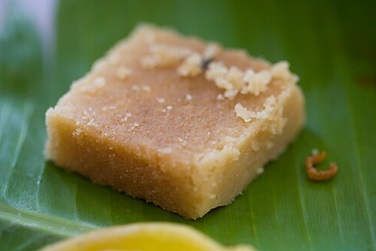
Honey is considered the earliest sweetener. “Guests were welcomed to a household with madhuparka, a honey-sweetened concoction of curd and ghee.” [1, 37] Rock sugar (kand) is thought to have been known at least by 800 BCE, with modern exemplars such as Gulkand (Rose-jam) being used to this day. Confectionary may date back to the Vedic period with different combinations including cardamom, ginger, and ground barley/wheat with jaggery to make abhyusa.
“Some of these confections were artisti-cally shaped. The rice-flour sweet preparation, modaka or madhugolaka, looked like a fig, and the barley flour confection, shastika, was cone-shaped and had delicate surface markings. By late Buddhist times, some sophisticated sweets are mentioned. The mandaka, now called mande, was a large parata suffed with a sweetened pulse paste, which was then (as now) baked on an inverted pot: madhusarika was a sweet cake; morendaka, made from khoa, was shaped like the eggs of a mora (peacock); gulala-laavaniya was perhaps the modern gole-papadi, a tiny fully-expanded puri…Rice cooked in milk and sugar was payasa, a popular sweet even now“. [1, 39]
Rice, of course, is so central to Indic cuisine that it was cooked in a variety of ways and forms. Rice cultivation has been radio-carbon-dated at Prayag going back to at least 5000 BCE, though terraced fields for rice cultivation have been dated to 10,000 BCE in Kashmir. As for types of rice, the most common is Oddana (boiled rice). Pruthukam is beaten rice (poha) and neevaraa is wild rice [1,184]. Then there is laajaah, the ritually pure form of parched rice, mentioned in the Ramayana as well.
“The early canonical literature of the Buddhists and Jains (c.400 BC) again reveals extensive use of fine rice (shaali) or ordinary rice (vreehi), either boiled, or cooked with til seeds, or made into gruel (yaagu).” [1, 34]
Terminology
- Soopa—Soup/pulse/sauce
- Ksheera/Dugdham—Milk
- Navaneetham—Butter
- Thakram—Buttermilk
- Ghrtam—Ghee
- Dadhi—Curd
- Daddhojanam/Dadhyannam—Curd Rice
- Ruchikaram—Tasty
- Themanam— Curd-Sambar
- Thandhoola/Annam/Bhatka—Rice
- Pulaaka—Pulao
- Yava—Barley
- Rotikaam—Roti/Chapaathi
- Rasa—Juice/Flavour
- Chaayam (now Chai)—Tea
- Kalaaya—Peas
- Vataka—Vada(these are mentioned in the Dharmasutras as being fried in ghee)
- Parpatam—Paapad
- Sharkaraam(“aapke muh mein ghee shakkar!“)—Sugar
- Lavanam—Salt
- Mareecha—Black Pepper
- Pippali—Long Pepper
- Lashuna—Garlic
- Jeeraka—Cumin
- Haridra—Turmeric
- Paanakam—Juice
- Kvathitham—Sambar
- Vyanjanam—Curry
- Upadamsam—Pickle
- Thailam—Oil
- Upasechanam—Chutney
- Shaaka—Vegetables
- Vrntaaka—Brinjal
- Sevika—Sev
- Paaka—Cooking
- Ruchi—Taste/Flavor
- Ruchikaram— Tasty
- Sthaalikaa—Plate
- Spoon—Chamasa
- Knife—Churikaa
- Chashakam—Glass
- Sankocha—Reservations
- Bhoori bhojanam—Great feast
- Bhojanam—Meals/lunch/dinner
- Praatharaasha—Breakfast
- Madhurabhakshyam—Sweets/Dessert
- Thaambhoolam—Betel nut
- Khaadyathe—Eat
- Bhojanam krtva—Have meals
- Pariveshayathe—Serve food
This article will naturally focus more on the traditional native fare of Bharatavarsha. While it is true that food, like most aspects of culture, is not static, it is also important for native identity to not be lost to syncretism. It is possible to admire what is good about others while appreciating your own uniqueness.
If at all u want to promote ur state cuisines.. U have to stop this appeasement 😑 Building a brand needs continuos effort for years. https://t.co/bNA7MKWNvK
— Sheetal Mishra 🌼 (@itssitu) June 5, 2017
Therefore, rather than hewing to the hyperactive hungama of invented “Ganga-Jamuni Nautanki“, this Post will focus on the core Indic aspects that can be traced back with continuity to Ancient India. These elements are very much alive today, and in regions such as Andhra and Odisha, predominant.
Contributions
§ Focus on Food as part of an holistic System of health. Application of Ayurveda pervades Paaka Darpana of King Nala.
§ Use of Mustard seeds, Turmeric, Cumin. These essential ingredients to “Curries” are as ubiquitous in ancient Harappa as they are in modern Himayatnagar.
§ Tandoor (originated in either Rajasthan or Punjab ). [1,107] The word comes from the Sanskrit “Kandu”. Thandoora is the word for grilling.
§ Khichadi/Khichdi/Khichri. In the Vedic period, rice cooked with milk and sesame seed was called krsaara, and is considered to be a forefrunner to khichdi, which is made from rice and dhaal. [1,33]
§ Thali is the common word for the round plate of plenty throughout India. The word comes from the Sanskrit ‘Sthaalikaa’.
There, of course, countless other culinary aspects to discuss. But food history (as with history in general) is subject to great controversy. In order to separate the genuinely Indic from the colonially syncretic, we will discuss some of the issues here:
Biryani is foreign origin (coming from the Persian Beryan), but…
Pulao is definitely native to India and comes from the Sanskrit word Pulaka.
…meat cooked with rice is referred to in the Yagnavalkya Smriti as pallao-mevach, and the word palao also occurs in early Tamil literature [1, 54]
Other varieties of savoury meat & rice dishes are mentioned in the Ramayana. One such dish was called maamsabhutaudana: rice cooked with deer meat, vegetables, and spices. The Mahabharata mentions pishthauddana, another rice dish, this time cooked with minced meat (other kinds include, sour meat, fried meat, ground meat, grilled meat, and meat for stuffing). [1, 54] In fact, rice being the major staple, it is only natural it was cooked in many forms. Odana is rice boiled in water or milk, often along with curds and honey. When this combination is cooked with meat it was called mamsaudana. Khichadi is another common denominator throughout most of India. So much so is this the case that the term “Khichadi couple” has been invented by NRI/PIO desis to refer to couples coming from “2 States” or more, but being 100% Bharatiya.
Traditional Indic sweets are called madhuraani in Sanskrit (or mithai in Hindi). Some sweet items such as Rooh Afza and Jalebi (zlabia) are obviously foreign origin. But many, many more are local (and given foreign origin by sepoys). In fact, the whole assortment of traditional Bengali sweets are said to be “phoreign” because apparently “yeverything kayme from mughal!”. This is of course ridiculous. Many have argued that Kulfi is a recent addition, and that is probably a fair assessment, though iced dishes were certainly well-known in snowy Kashmir. It is, therefore, here that we shall begin:
Regional
Each region (indeed, state) of historic Bharatavarsha has evolved unique aspects of aahaaram while hewing to integral aspects of Saastric gastronomy that unify the Subcontinent. While all can’t be covered in a single (digestible!) article, here are some highlights to give a Gastronomical Survey of India (GSI).
Kashmir
On the extreme left – That's how actual Kashmiri Dam Aloo looks. Another of Kashmiri Veggie Thali 🙂 pic.twitter.com/WrnuslBflS
— Aashish (@kashmiriRefuge) February 25, 2017
From Rogan Josh to its eponymous Pulao, Kashmiri Cuisine is rightly appreciated by sophisticates of all sorts. Although the ancient nobility of this famous region is now diminished, Kashmiri Pandits have maintained most of the traditional fare, with rare dilution. Known for its Wazwan (multi-course) meals, the Crown of India’s cuisine features such spices as asafoetida, methi, and ginger. Nevertheless, as evidenced by Kashmiri Pulao, saffron (kesara) is the signature spice, and has been cultivated here since ancient times. Though arguments are often made supporting foreign introduction, it’s fairly clear the use of saffron is indigenous. Here are some of the finer points of this cuisine:
“The Kashmeerees have been bons viveurs and are proud of their cuisine which is justly famous. ‘Snigdha’ sug-gests the use of oil to which the Kash-meeree chef de cuisine still adheres in preference to the melted butter (ghee) used in the Panjaab. The Kashmeeree Brahman is a lover of meat and fish and in ancient times grape wine was in common use. The Nilamata Puraana mentions the use of wine for ceremonial purposes.” [5, 555]
“The nobility and courtiers in the typical bon viveur style enjoyed the Kashmiri cuisines which is justly famous; they had ‘fried meat’ and ‘delightful light wine cooled with ice and per-fumed with flowers.’…As for the common people, they subsisted on rice and hakh (Kashmiri greens)” [5, 23]
That's Kashmiri Maunj Hakh (Also known as Ganth Gobi or Kohl Rabi). What most mom's love 🙂 #KashmiriDishes pic.twitter.com/tADvHBhgmI
— Aashish (@kashmiriRefuge) February 25, 2017
One “could not do without the soft and unctuous fare of Kashmeer, which is easy to digest when washed down with sugared water whit-ened with chunks of ice.” [5,555]
Interestingly, the lotus is not just a symbol of prosperity, but also a focus of the dietary. “Vegetables start in the Rigveda with the lotus stem (visa) and cucumber (urvaaruka), fol-lowed in the later Vedas by lotus roots (shaaluka)“. [1, 35]
Jokes are often cracked, usually by natives themselves, about how Kashmir is a land of literal and figurative lotus eaters. It is not without cause.
“Lotus roots is a favourite dish of the Kashmeeree Brahmans. In the plains of India the dried roots from the homeland are imported as a delicacy. Seeds of the lotus…are also eaten.” [5,459]
Regardless, conventional staples are also popular in Svarga’s own Aahaara. Plain rice and assorted sweet pulaos (featuring fruits and nuts) are popular, as are breads such as kulcha, tsachvaru, and girda.[1]
Jammu and Ladakh, naturally have their own notable contributions. Dogras typically eat wheat, bajra, and maize along with rice as staple.
Andhra

Much of the Cuisine of the South shares certain well-known dishes, which are fought over with a ferocity that makes the great Rasagolla Wars of Eastern India pale in comparison. Nevertheless, there are certain distinctive state characteristics. Since a perennial question for most non-Southies has been “What is the difference between Telugu and Tamil?”, allow this Andhraite to elaborate.
Andhra Cuisine stands out for a number of specialities, first and foremost is the use of spice. While mirchi is a near-Pan India practice, it reaches its fever pitch in Bahubali’s own Country, hence the justifiable reputation of having the spiciest food.
In fact, it packs such gharam dharam that the following saying has become a saametha of sorts about Andhra men.
Andhra men like their food as they like their women: Presentation is very important…and they prefer a little Spice.
Roselle leaf (gongura) is another key ingredient. While use of the green gram (mudga) dates back to King Nala’s time, it has taken a unique incarnation in that Andhra specialty known as Pesarattu:
Though tamarind is used widely in the rest of the South as well, it is a critical part of the Telugu dish known as the pulusu ( a tamarind sauce/stew).
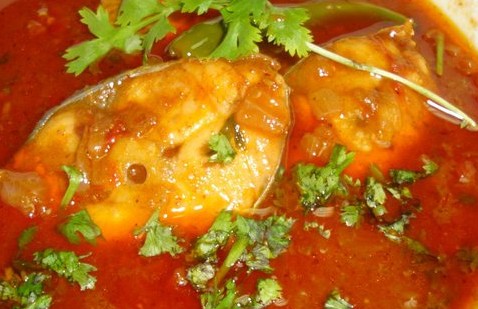
The new state of Telangana also has some regional, yet truly native, specialities, such as sarvapindi and sakinalu. But these snacks, and more robust entree-fare, can be covered separately. The notable aspect is what unifies undivided Andhra in the food department.
The South (in General)

The use of pickles (uragaaya/urakai) is quite common throughout the south, and are the ideal complement for daddojanam (curd rice), preferably with a little mustard seed.
That all-India favourite, Dosa, is seen as Udipi-derived (so there’s a win for Karnataka), but if that’s the case, you Kannadigas will have to take the blame for Bisi-bela-baath (sorry guys…it’s true…). Before the other side of that great Kaveri war gets upset, yes Idli is very likely a Tamizh contribution (though our sepoys are doing their utmost to invent an Arab origin…probably while smoking some pretty powerful hookah). Though it should be noted that the Manasollasa mentions both the dhosaka (dosa) and idarikaa (idli).
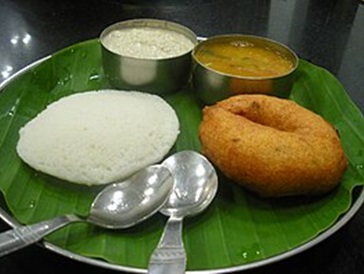
And before our Mallu friends think I’ve forgotten them, there is much that Kerala has to offer—especially when it comes to all things coconut. Unni-aapam (jackfruit-rice pancake) and coconut aviyal are two must haves from the land of Kalaripayattu. The ancient Chera country was also famous for its pepper.
The Kodavas of Coorg also have a distinctive cuisine, and are known for their preparation of pork-based dishes. Tulu cuisine is embodied by various Mangalorean fish curries.
South Indian fare is not all vegetarian as has popularly come to be believed. In fact, the most carnivorous (or more correctly omnivorous) states are found south of the Vindhyas, with Kerala leading the pack. Rasam is of course common to pretty much all the Southern states, but I would argue that Andhra’s Tomato Chaaru is the most sophisticated form of this savoury soup of Soopa Sastra.
Maharashtra
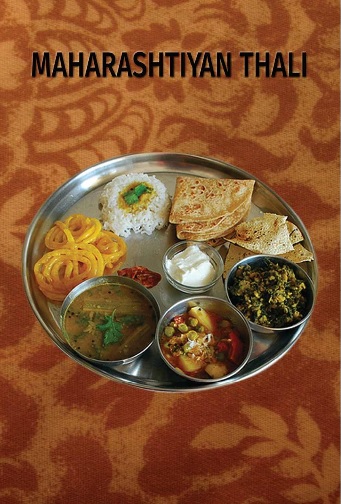
Core components of Maharashtrian cuisine are discussed below; nevertheless, Amba Kesari Bhaat is one signature dish. Maharashtra is likely the place of origin for Shrikand (in its present form). The etymology of the word comes from, yes, Sanskrit. “Shikar-ini, the modern shrikhand, also employed strained curds, crystal sugar and spices.” [1, 35]
Konkani khaana is close related to Maharashtra’s, though distinctive in its own way. Tambli (bondi chutney) and Banana flower chutney are standouts. There is also Amlechi Uddamethi, which is a raw mango curry. Fish is an important component as well.
Gujarat
Gujarati Thali from Piccolo Restaurant @ Surat 😀
Itne main toh 10 log khana kha lein! pic.twitter.com/88Q0nHkmdo— Naina (@Naina_34) September 18, 2014
Though Madhur Jaffrey has posited it as “Haute Vegetarian Cuisine”, something that Rajasthanis and Vegetarian Punjabis will contest ipso facto, there is a distinct variety of dishes that come from this ancient commercial entrepot.
Arguably the most entrepreneurial region in India, this partially dry but mostly coastal state in India has given and taken influences throughout the millennia and developed its own style of foods too. Dhokla and Rotli are common markers of the Gujju menu (as is sweetness even in staples), and Daakor na ghota (spicy fried dumpling) is another gujarati item. Saboodana shakes are recent addition too. Namkeen is the notable western Indian snack specialty, one which Gujaratis raise to a high artform with various kinds of Chaat that reach their peak in heavily Gujarati Mumbai (take that, Thackerays!).
Want to live up like the royals? Indulge in a Rajasthani Thali! #foodiealert #fooddelivery #healthyeating #goodfood pic.twitter.com/vRSr11Be5e
— Akshay Dhoot (@TheFoodWheel) March 31, 2015
Rajasthan features many different varieties of food. Its vegetarianism is predominant, though not universal. It has produced many popular traditional items such as Baati (Rajasthani bread) and Bikaneri Pulao and Bhindi Jaipuri. Kalakand is considered a native Rajasthani mithai. Undhiu is undoubtedly a western Indian dish, but Rajasthan and Gujarat can fight over it.

If you are born in a Marwari household, 30% of your body fluid is water and the remaining 70% is Ghee. My Blood Group is Ghee Positive.
— Sagar (@sagarcasm) January 11, 2015
Central India
Madhya Pradesh, Chattisgarh, and Jharkhand all have their own flavours and cultures. MP itself prominently features two key regions: Malwa (ancient Avanti) and Bundelkhand (ancient Chedi). Jowar has traditionally been common in this part of the country. For the sake of article limitations, a few quick mentions will be made here, to be expanded upon at a later date:
- Saboodana Khichdi
- Dal Poha
- Indori Fried Garadu
- Farra
Uttar Pradesh/Bihar/Nepal
FOODIE BIHAR
——————–
Bhojpuri Thali… pic.twitter.com/TTg82TwS0J— Bihar Foundation (@biharfoundation) July 30, 2015
Admittedly this is a very large region to cover, particularly if one includes now separate state Uttarakhand in the mix. Nevertheless, distinctions can be discussed in a different Post as there are some broad similarities in this core Gangetic region that has traditionally grouped them together (those hailing from this parts are welcome to give their thoughts via comments). Roti, barley, and even raagi are all in use. Baath (boiled rice), however, seems to be the core staple. “Boiled rice flour cakes were termed khir-aura, phara meant steamed rice balls, and phu-lauri was a steam-cooked roll of coarse flour.” [1,140]
As for Bihar in particular, a plump rice known as shaali was grown in ancient Magadha and was served to honoured guests. Sattu (flour of roasted pulses) is commonly used as are barley grits, combined with salt or sugar. Sattu as drink is considered the marquee beverage for Biharis.
Other dishes include laai (parched rice), chiuri (parched barley), lawaa (parched maize), and lapsi (flour of any grain boiled in milk and sugar). As for desserts, various laddoos are favoured, such as fine-grained motichoor and sesame-seed tilkut.
Nepali cuisine shares much in common with Pahari food. The standard Nepali Thali is Dal-Bhaat (rice and dhaal). Dhido is a traditional wheat staple from Nepal made from water and grains like buckwheat.
Odisha
https://twitter.com/swetapadma07/status/786103451310813184
Due to the long-running (and justifiable!) Odisha irritation with Bengal claiming Rasagolla (and Jayadeva!), we shall begin with the Land of the Lingaraja Temple and their unique cuisine. The Kalingas may have Konark and Kharavela, but the state famous for Jagannath Swami of Puri also packs a punch in the food department. Indeed, the origin of the Rasagolla is said to be Lord Vishnu’s way of saying sorry to Lakshmi Devi for his going on yatra without her granting leave (an abject lesson to all the non-divine husbands out there!).
Nevertheless, as in most other states, rice, wheat, and barley are all state staples. Pakhala (boiled rice covered with water and kept over night) is one item unique to Utkala.
And if you’re in the mood for something more casual, the state has plenty of snack foods to offer as well
#Odias have some unique Street food options. Dahibara aludum, mudhi mansa and bara ghuguni to name few #utkaladibasa #Odisha pic.twitter.com/4SORU5Yhx5
— Sheetal Mishra 🌼 (@itssitu) April 1, 2017
Bengal
A bite of Bengal: 6 food souvenirs to bring back from Kolkata https://t.co/zzgTdNfhso pic.twitter.com/maPpfQuJgM
— NatGeoTravellerIndia (@NGTIndia) March 15, 2016
The very mention of Bengal and Food may bring to mind not only “jal pushp”—better known to the rest of us as fish—but one of the most celebrated varieties of sweets on the subcontinent: Mishti-doi (sweet curds for dessert), malpua, khoa, Sitabhog, nadu, and of course, the state sweet, Sandesh. Another notable confectionary factoid: “Krishna Chandra Das invented the rasamalai, flattened chhaana patties floating in thickened milk”.[1,132]
These are just some of the scintillating sweetmeats and salivational (portmanteau) savouries south of the Siliguri. These confections are well-known to most Indians, though some are the subject to squabbles (such as the now confirmed Odia claim to Rasagolla already mentioned). In any event, there are other aspects that merit mention as well.
There are two distinct styles: East and West Bengali. East Bengali is low on dhaal and high on fish, while the West is known for use of poppy seeds (posto). [1,129]
Barley’s importance in the Vedic period is preserved in modern Bengali cuisine.
It was fried and consumed in the form of cakes dipped in ghee, or as sweet cakes called apupa fashioned out of the flour, boiled in water or fried in ghee, and then dipped in honey. The modern Bengali sweets pua and malpua preserve both the name and the essen-tials of this prepartion. [1, 33]
Rice is a big part of the Bengali diet, with a medieval text (Shunya Purana) stating there were 50 varieties grown in Bengal. [1,128]
Northeast
Manipur Thali pic.twitter.com/BjqBjupoxm
— 《$ @ n + 😍 s H》🎭 (@san_officl) July 19, 2014
The Seven Sisters of the Northeast have their own offerings of civilizational savouries to offer, starting with Assam (The other sisters being Manipur, Mizoram, Nagaland, Tripura, Meghalaya & Arunachal Pradesh—though we can include Sikkim so no one is left out).
While distinct dishes exist in the various cuisines here, pork is common throughout. Rice is the staple for the most part and fish very popular. Given the diversity of offerings, they are best treated in a separate piece.
Sinhala
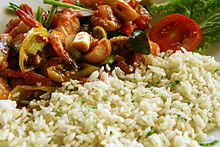
The good people of Sinhala are very much Indic in blood and culture, and so, their food also deserves a mention here.
While rice is also a staple, the island of Ceylon features many heavy influences, notably South Indian, Indonesian, and European. Seafood is obviously a key component. Some unique dishes include Pittu (cylinders of steamed rice mixed with coconut) and kokis (coconut biscuits).
Sindhi
Not Bad!!
Nothing beat this taste of Sindhi Breakfast 😍😎#DalPakwan #SindhiBreakfast pic.twitter.com/Gkq2hbiWuS— Ashish Punjabi™®♚ (@iAshishPunjabi) May 17, 2017
With a taste that will make you say “Jai Jhulelal!” even when it’s not Chetichand, Dal Pakhwan is one of the most beloved breakfasts in India. Rice is obviously a staple of Sindhi food, but flat-breads such as roti and koki are also common.
Hilsa fish curry is a signature dish and Thadal is a signature beverage. Sanha pakoras and chola dhabal are other notable food items. There is also a special Sindhi Papad that is well-known among most Indic gourmets.
Punjabi
https://twitter.com/SelfieRobot/status/676430184367656960
Last but certainly not least is the Land of the Five Rivers (surely, Punjabi mundian aur kudian, you didn’t think we’d forget you?!)
Punjabi khaana deserves a separate article (or series!) of its own. Along with the putative trend of Punjabification throughout India since the 90s (some would say for better or for worse), Apna Punjab has been at the forefront of marketing Indian Culture. But while Bollywood, Bhangra dance, and Punjabi Pop music can be discussed at another time, Punjabi food is very much a topic for the present. In fact, as recent research has determined (and as many Indians have long suspected), much of much-vaunted “Mughlai cuisine” is in fact from Apna Punjab originally. One Professor from the University of California Los Angeles wrote that:
“There are a hundred different cuisines all over the country, each claiming to be the best in the country, if not the world, yet two styles have become popular among visitors to most major cities and towns countrywide: Mughlai, which is vegetar-ian and nonvegetarian, largely Punjabi, with a somewhat liberal use of ghee (clarified butter) and the use of a tandoor (an oven usually implanted in the ground), and South Indian vegetarian cuisine, which is somewhat less oily but spicier.” [8, 6-7]
Rich in butter, such favourites as mattar paneer, murgh makhani, and makkhi roti all hail from the Pancha-naada. As such, perhaps the time has come to give credit where credit is due. Surely kheema and and haleem are not native, but paneer, paratha, bhatoora, tandoori, along with that Punjabi favourite, Lassi, definitely are. In fact, the most ancient tandoor to date dates back to it.
The word Paneer (like the word Kalamkari) may have foreign word origins, but both are very much native Indic and very ancient. Whether it was common throughout ancient India or not, it has certainly come to refer to the Punjabi farmer’s cheese that is beloved by vegetarians the world over, and certainly within Bharat.
Conclusion
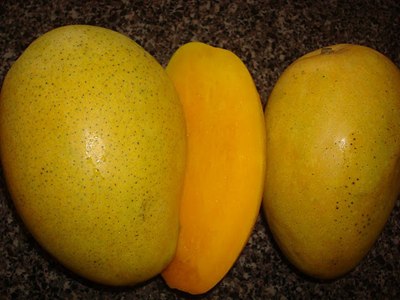
Perhaps most interesting is the question of whether the conventional wisdom itself has things correct. Is a paradigm shift required on recently ascribed beliefs regarding the origins of many Indianised foods? One example is the kebab. Noted Indian food authority K.T. Achaya writes:
Meat roasted on a spit (shula) is graphically described in the Mahabharata…and in south Indian literature…The modern kabab has therefore a long history in India [1,101-102]
As seen above, whether it is crediting for biryani or for falooda, the truth matters more to us than any nationalistic claim. And yet, as we have seen with the idli, appropriation has been the frequent aim of Non-Indian Residents (NIRs). Is the kebab actually bhaditraka as one Oxford press pustakam prescribes?—or is it qualitatively something else? The time has come for Food Historians (and Tandoori Nationalists) to do serious research into these issues. Contrary to “yeverything kayme from mughals” types, Ancient Indian Culinary texts do exist (much to their dismay, no doubt). But it is equally important to carefully study claims (whether pro or anti) so that the authentic is revived from the quagmire of the syncretic. The best way to appreciate other cultures is to first appreciate your own—that is true cosmopolitanism.
Dining etiquette around the world part two. India 🍲 Thailand🍤 China🍚🍜 pic.twitter.com/a0Bds53PuZ
— People To People (@PTPI_CAG) June 9, 2015
Are chillies and tomatoes and potatoes all foreign origin? Evidence would suggest that chillies may not be (it was known to Purandara Dasa [1,227]), tomatoes likely are, and potatoes almost definitely so. In fact, in the Andhra-bhasha, potatoes are referred to as bangal-dhumpa (or Bengali rhizome) indicating their arrival via British-ruled Bengal. Nevertheless, the very likely foreign origin Aloo has certainly been Indianised over the years. Yams were likely the native precursors to it. And what about that modern favourite, Samosa? Sorry folks, evidence points to the mid-east. But that being said, Pakoda, Bhajji, and Bhelpuri are all Bharatiya…pakka.
Nevertheless, appropriation of all things Indian under the neo-construct of “Mughlai” is well known. One can see here that malpua, phirni, and pulao (all Classical Indic classics) are being appropriated under the “mughlai” label. This doesn’t mean going the other way and not acknowledging obvious imports (falooda, jalebi/zlabia, biryani), but it does mean intelligent and discrete people must start asserting rightful claims over their state’s cuisine culture. Odias have shown the way with rasagolla.
All Indians, vegetarian and non-vegetarian, should come together to preserve their ancient claims to pulao, tandoori, and a litany of other culinary contributions to world cuisine. Just because some foreign or foreign-sponsored professor wrote a food book, doesn’t mean everything in it is true. Appreciate what is native, acknowledge what is foreign, and reserve judgment on what we genuinely don’t know. That is the proper path not only for wise people, but also connoisseurs of all kinds—culinary or otherwise.
Since others are trying to serve us humble pie on a platter, let us show them our capacity for good digestion. So rather than say bon appetit, we sign off with that signature line from that sacred Saptarishi Agasthya Mahamuni: Jeernam vaatapi, vaataapi jeernam.
Annam means food. According to Hindu scriptures, annam is a form of Brahman (annam parabrahma swaroopam).
Hindu… http://t.co/MkphQ9q6xK— dr.rajshri@ (@dr_rajshri) August 7, 2015
References:
- Achaya, K.T. Indian Food: A Historical Companion. New Delhi: Oxford University Press. 1994
- Madhulika, Dr & Ed. Jayaram Yadav. Paka Darpana. Varanasi: Chaukhambha Orientalia. 2013
- Tripathi, Vaishali. Traditional Indian Thali. Chennai: Notion Press.2015
- Ramayana. http://www.valmikiramayan.net
- Pandit, R.S. Kalhana’s Rajatarangini.Delhi: Sahitya Akademi. 2015.
- Basham, A.L. The Wonder that was India. New Delhi: Rupa. 1999. p. 190
- Rangarao, Shanti. Good Food from India. Bombay:Jaico.1977
- SarDesai, D.R. India: The Definitive History. Westview: Boulder, Colorado. 2008






![[Reprint Post] On High Culture: Beyond Bollywood](https://indicportal.org/wp-content/uploads/2015/08/805-150x150.jpg)

